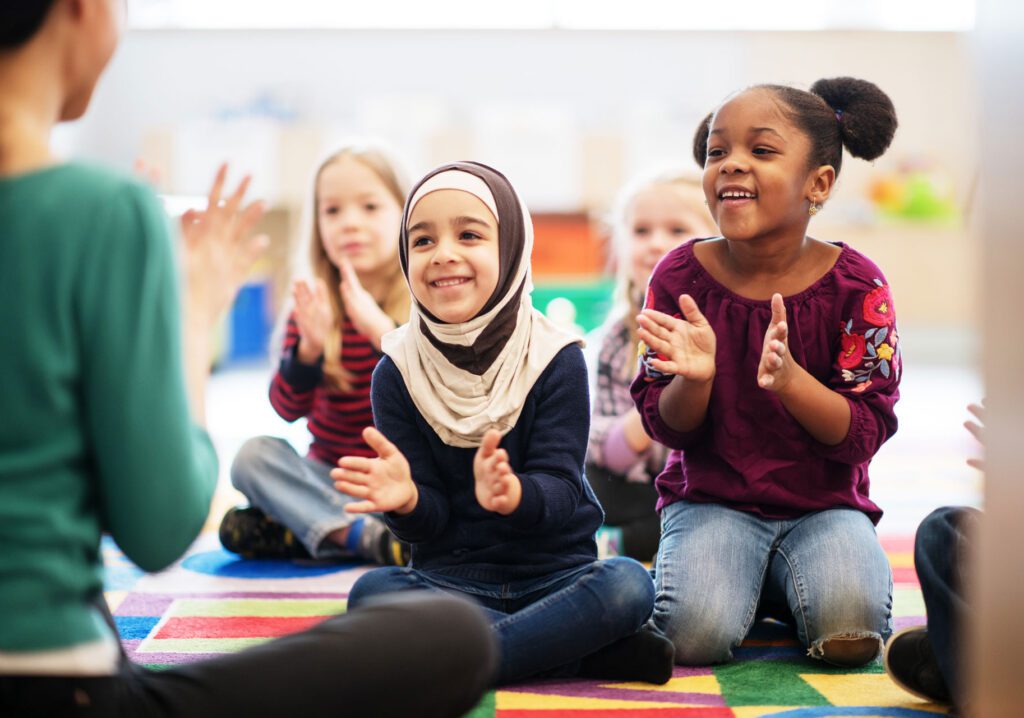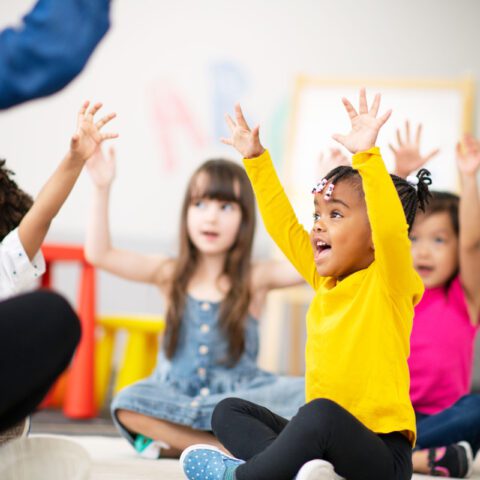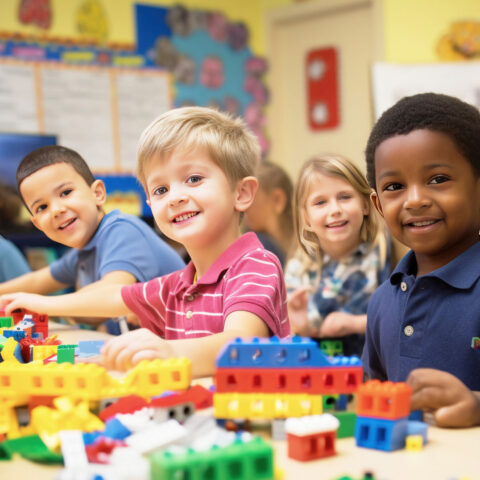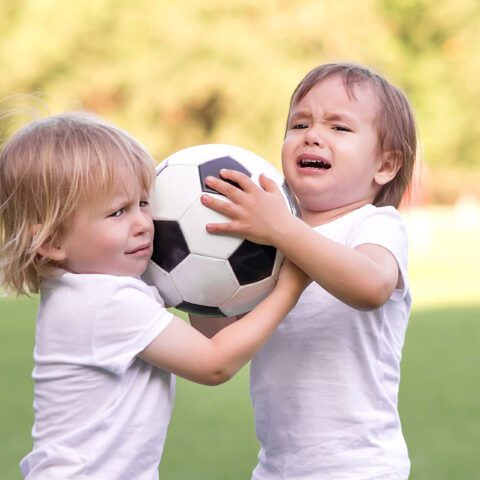Put inclusive teaching methods into practice.

Apply Your Knowledge
Put inclusive teaching methods into practice.
As we teach and interact with young children, we should make it a priority to prepare them for life in a diverse world. We can achieve this by engaging in meaningful conversations with children, teaching them how to be friends and allies, and intervening when necessary to help children develop more inclusive ways of interacting with others.
You may worry that the concepts of gender diversity, family diversity and different types of relationships are too complex for young children to grasp. But children notice and respond to differences, underestand the concept of diversity, and generally ask very predictable questions about gender and LGBTQ+ people. You can easily prepare yourself for these questions by visiting our page on How to answer children’s questions about gender and LGBTQ+ people.
This is a good time to address the elephant in the room: Some adults shy away from conversations about gender identity and sexual orientation—often because they fear that these topics will lead to discussions about sexual activity that are not age-appropriate. But these fears generally arise when adults project adult ideas and concerns onto the early childhood curriculum.
Teaching children about gender and LGBTQ+ people is developmentally appropriate, instructionally beneficial, and morally and socially just. But we must do this work while keeping the life experiences, needs and developmental levels of early learners in mind.
Click on the tabs below for inclusive teaching suggestions. As you review these suggestions, you will begin to see that incorporating Early Pride into your teaching does not have to be overwhelming, overly complicated or controversial. The interests and needs of the children in your early childhood program—as well as the questions they pose—will guide you on your journey as an anti-bias educator.
Showcase diverse families.

Represent diverse families in meaningful ways.
Ensure that the family representation in your classroom is meaningful and diverse. Use posters, photographs and illustrations of diverse families—as well as inclusive children’s books—to introduce children to different types of families, teach other basic concepts such as daily routines, or introduce children to life within an LGBTQ+ family.
Interactions with actual LGBTQ+ family members will bring the concept of family diversity to life in a way that no two-dimensional photograph or illustration can. Encourage LGBTQ+ family members to visit your classroom and share photos and stories about their daily lives, and let these family members know that should not feel any pressure to focus on LGBTQ+ issues.
Talk about differences.

Open dialogues about differences.
Initiate conversations about children’s commonalities and differences. Point out and celebrate these differences, validate diversity, and normalize conversations about the following topics:
- Different types of families
- Our unique physical characteristics such as skin color, hair type or style, facial features, and height
- The unique interests and play preferences of different children
- The many ways that people express their identity, creativity and interests through clothing
- Gender as claimed and shared by the children, rather than a gender identity that adults assume and/or assign
Incorporate diversity into play.

Introduce children to the reality of a diverse world.
As you select action songs and fingerplays that represent diverse families from around the world, you will broaden children’s perspectives and expose them to different languages, types of movement and musical styles. You can also adapt familiar songs and fingerplay in the following ways:
- Change song lyrics to reflect family diversity. For example, use “mommy and mama” instead of “mother and father.”
- Look for songs that feature people and experiences that are familiar to the children in your program, as well as songs that openly celebrate diversity and human differences.
- Combine familiar melodies with your own lyrics. Incorporate the families and interests of the children in your program and adapt these lyrics when possible to include the names of their family members.
Focus on empowerment.

Help children develop a sense of personal agency.
The ways that we support children as they learn how to navigate in the world may not seem to be related to gender identity or LGBTQ+ inclusion, but they are. Even when children are very small, our efforts to help them develop a sense of personal agency—so that they feel empowered to determine their own actions and life circumstances—are critical to their identity development.
We want to help children feel confident about their choices, as well as their problem-solving and conflict-resolution skills. Yet, too often, we focus on evaluating, correcting and directing children rather than empowering them. This approach undermines children’s confidence and discourages them from trying out new activities and experiences. They are less inclined to take the initiative and more likely to look to adults for permission, guidance and approval.
So how can you empower children to be more assertive, expressive and supportive of one another? Try out some of the suggestions below:
- Encourage children to share their ideas and plans with others prior to large group or center times.
- Instead of asking questions about a picture that a child is drawing or a block tower that a child is building, provide feedback such as “The children in your spaceship drawing look like real astronauts” or “You built a very tall tower with these blocks!”
- Rather than evaluating children’s efforts with bland phrases such as “great job,” go deeper. Ask questions such as “How did you keep this block tower from toppling over?”
- Compliment children’s thought processes and problem-solving skills, rather than focusing solely on the end product.
- Validate children’s creativity as they express themselves through pretend play and art activities.
- Show empathy when children are having a hard time. Use phrases such as “I can tell you are really upset about that” instead of minimizing or invalidating their feelings with phrases like “You’re okay.”
- When conflict arises, help the children involved see each other’s points of view. Use phrases such as “He’s telling you that he doesn’t like it when you push him,” rather than intervening and taking control.
- Give the children a sense of control and put them in touch with their emerging ability to solve problems by asking questions such as: “What could we do to make things better?” Offer choices, rather than enforcing solutions when children are in conflict.
Be a social-emotional coach.

Lay the foundation for friendship and allyship.
By supporting children’s social-emotional development, you can help lay the foundation for a better future for LGBTQ+ people. Early childhood is an ideal time for this work.
Young children are often referred to as “ecocentric,” and adults often comment that children under the age of five “have a hard time sharing.” But this characterization focuses on deficits rather than brain development. Children at this stage are still learning how to deal with their own emotions and the emotions of their peers. When they join your early childhood program, they must also figure out what it means to be part of a community.
That’s a tall order for these little ones, but there’s a lot you can do to help. If you’re wondering how to begin, check out the tips below:
- Try not to minimize a child’s emotional distress with phrases such as “Be a big boy and don’t cry.”
- When conflicts between young children arise, rather than enforcing rules with comments such as “You need to share,” use these situations as opportunities to build social skills and foster mutual understanding.
- Help children develop an awareness of other children who are sharing their space with comments such as: “Marty wants to share the block area with you.”
- Read books about children who successfully navigate conflict and/or surmount challenges.
- Give children the gentle guidance they need to make emotionally intelligent choices in everyday situations.
- Introduce emotional vocabulary words into your book shares and other activities. When children can attach words to their emotions, they become more aware of their feelings and can communicate these feelings to others.
- Interpret behaviors so that children have a better understanding of the needs and feelings that are driving their peers’ behavior. Try using statements such as: “That is her way of getting your attention. Let’s see what she needs.”
- Accept and interpret children’s emotions rather than sending the message that these emotions are not appropriate or important.
- Acknowledge challenging emotions without using the word “but.” In other words, respect the fact that certain situations are difficult for young children. Instead of dismissing their disappointment or frustration with a comment such as “I’m sorry you’re upset, but that center is full,” acknowledge their feelings and offer to help. A comment like this one can do a lot to drain the emotion out of a situation: “I know you’re disappointed that you can’t play with the blocks. How can I help?”
- Model, acknowledge and teach positive social interactions. Young children naturally take turns and share—even before they are conscious of these behaviors as acts of friendship or generosity. Notice, celebrate and talk about these behaviors.
- Visit our inclusive children’s book section for books and teaching guides about friendship and allyship.
Use conflict as a teachable moment.

When conflict arises, seize the opportunity!
Teachable moments in early childhood settings often come in the form of conflict. When this happens, don’t step in as a fixer or an enforcer. Instead, model problem-solving skills and help children develop the social-emotional skills and emotional vocabulary they need to solve problems on their own.
- Step in when necessary to help children identify problems. Rather than saying, “You need to share,” say “It looks like you both want this toy. Let’s see if I can help.”
- Help children understand one another better by interpreting their actions, emotions and language. Use statements such as: “They are telling you that they want to play with you.”
- Reinforce children’s attempts to resolve typical issues that come up during play.
- Encourage children to stand up for one another. When a child asks for your support when a peer has been victimized, this is allyship, not tattling!
- Don’t deny the reality of children’s experiences. “We don’t do that in this classroom” is a phrase that's often used by teachers to describe behaviors that children see all the time!
- Address name calling and other hurtful behaviors.
- Challenge observed instances of teasing/bullying, including teasing or bullying that is related to play choices or family structure.
- Keep the lines of communication open with families so that they can share and respond constructively to conflict.